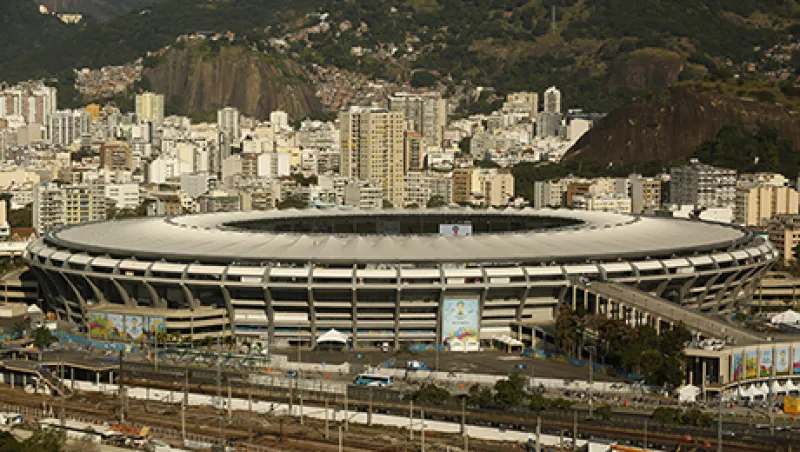After the 41,000-seat Arena Pantanal in Cuiabá hosted the last of its four group matches in late June, the posttournament conundrum for Brazil’s big World Cup infrastructure projects lurched into view. Now what?
The case for a permanent stadium of that size in this city of 550,000 was always questionable. “In many places the stadiums were built without a clear plan for what would happen to them afterward,” says Ricardo Camargo Mendes, a managing partner at Prospectiva Consulting, a São Paulo–based political consultancy. Cuiabá, capital of the state of Mato Grosso, deep in Brazil’s interior, is one such place: The city’s three soccer teams attract low match-day attendances, and the largest and most successful club in town, Mixto Esporte Clube, has not competed in the Campeonato Brasileiro Série A, Brazilian soccer’s top division, since 1986.
But local officials are adamant that the stadium will thrive. Beyond club matches, says Mauricio Guimarães, Cuiabá’s special government secretary for the World Cup, “we’ll open the stadium for corporate events. There’s very little conference space in Cuiabá, so the stadium can serve a very useful commercial purpose.” He admits, however, that he knows neither how much money would be required to keep the stadium open nor how much money the state government expects to generate from the structure in its post–World Cup existence.
The McKinsey Global Institute estimates the total value of Brazil’s infrastructure at just 16 percent of GDP, against an average of 71 percent for other large economies. Investment in Brazil accounts for just 18 percent of annual output, according to the World Bank; in India and Indonesia, by contrast, the ratio is at 30 and 34 percent, respectively. Yet Brazil’s deepening fiscal deficit means the government has little room to manage infrastructure funding on its own.
The World Cup offered Brazilian President Dilma Rousseff an opportunity to invest in major transportation and urban renewal projects to stimulate the next phase of the country’s growth. But instead of building the much-needed infrastructure “around the tournament that the country needs for the long term,” says Fernando Honorato, chief economist at São Paulo–based Bradesco Asset Management, which has $130 billion under management, the government focused, often for political reasons, on splashy new stadiums that as the 2014 World Cup nears its end look more like white elephants by the day. Stadiums in capital city Brasília and the Amazon frontier city of Manaus, which also lack popular, well-attended football clubs, face a similar existential threat as Cuiabá’s Arena Pantanal. “Brazilians were expecting the World Cup to be the driver of other infrastructure investment, beyond the work for the tournament itself,” says Honorato. Essentially, the World Cup paved the way for Brazil to get the stadiums yet produced none of the roads, ports, airport upgrades and other transportation projects it really needs.
But the experience of preparing for the World Cup may have finally brought the government around, belatedly, to more enthusiastic public-private partnerships, argues Honorato. Cuiabá’s stadium, like those in Manaus and Natal, was funded entirely with public money. Three other Brazilian World Cup venues — in Curitiba, São Paulo and Porto Alegre — were refurbished by the clubs that play in them. Public-private partnerships developed the remaining six, but there are few signs of a broader interaction between the sectors. “The government was extremely reluctant to open these projects up to the private sector to begin with; the approach was very ideological,” says Honorato. But, he adds, the pressure of the World Cup deadline plus the realization that fiscal deterioration gave the government little choice but to farm investment out to the private sector necessitated a compromise. It was that same sense of compromise that led Rousseff to open up three major airports to privatization midway through last year.
Around the same time, the government, in conjunction with the funds industry and major construction companies, designed a type of tax-exempt corporate bond specifically for infrastructure investment. Use of these bonds to fund projects to date remains minimal, but, says Honorato, “it’s a sign that the context for investment has improved.”
The real problem at this stage is that even though there’s now a pipeline of major projects and a channel to get private capital to them, the private sector is not willing to start investing again. With Brazil’s presidential elections coming in October, many investors are in a wait-and-see mode. Most observers expect Rousseff to win a second term. But the real question is whether her belated embrace of private investment will stick once the pressures of staging a World Cup subsides. “The major interest for public participation in infrastructure is development — but for the private sector, it’s profit,” argues Guimarães. “It’s hard to reconcile those two objectives.”
That view must change — and quickly — if Brazil is to jump-start the next phase of its growth.
Get more on emerging markets.







